Elderly Walking Access to Street Markets in Chile: An Asset for Food Security in an Unequal Country
Abstract
1. Introduction
2. Ferias Libres and Food Security in an Unequal Country
3. Data and Methods
Limitation of the Methods
4. Results
4.1. Potential Access by Older People at the National Scale
4.2. Potential Walking Access by Older People for Chile’s Main Cities
5. Discussion
6. Conclusions
Author Contributions
Funding
Institutional Review Board Statement
Informed Consent Statement
Data Availability Statement
Conflicts of Interest
Appendix A
| Metropolitan Area and Municipalities | Older People | % Older People in Each Socio-Economic Group * | % Older People with Access to Street Markets, per Socio-Economic Group | ||||||
|---|---|---|---|---|---|---|---|---|---|
| ABC1 | C2 | C3 | D | ABC1 | C2 | C3 | D | ||
| Metropolitan area of Santiago | 664,354 | 6.6% | 20.5% | 19.5% | 53.5% | 0% | 1.4% | 3.6% | 16.9% |
| Calera de Tango | 253 | 0.0% | 0.0% | 0.0% | 100.0% | 0.0% | 0.0% | 0.0% | 5.1% |
| Cerrillos | 9264 | 0.0% | 8.7% | 30.4% | 60.9% | 0.0% | 0.0% | 9.8% | 15.3% |
| Cerro Navia | 15,996 | 0.0% | 0.0% | 0.0% | 100.0% | 0.0% | 0.0% | 0.0% | 31.3% |
| Colina | 389 | 57.1% | 0.0% | 0.0% | 42.9% | 0.0% | 0.0% | 0.0% | 0.0% |
| Conchalí | 16,800 | 0.0% | 0.0% | 10.1% | 89.9% | 0.0% | 0.0% | 2.1% | 33.9% |
| El Bosque | 19,305 | 0.0% | 0.0% | 18.5% | 81.5% | 0.0% | 0.0% | 4.2% | 25.3% |
| Estación Central | 16,333 | 0.0% | 11.4% | 25.1% | 63.4% | 0.0% | 1.3% | 7.6% | 23.5% |
| Huechuraba | 9011 | 8.2% | 12.6% | 8.5% | 70.7% | 0.0% | 0.0% | 0.3% | 16.9% |
| Independencia | 10,734 | 0.0% | 0.0% | 58.1% | 41.9% | 0.0% | 0.0% | 11.8% | 17.0% |
| La Cisterna | 12,679 | 0.0% | 3.4% | 63.7% | 32.9% | 0.0% | 0.0% | 3.2% | 15.4% |
| La Florida | 45,113 | 0.4% | 23.9% | 35.2% | 40.5% | 0.0% | 1.5% | 5.1% | 16.1% |
| La Granja | 13,411 | 0.0% | 0.0% | 7.3% | 92.7% | 0.0% | 0.0% | 0.9% | 43.0% |
| La Pintana | 15,372 | 0.0% | 0.0% | 0.0% | 100.0% | 0.0% | 0.0% | 0.0% | 40.5% |
| La Reina | 13,306 | 19.2% | 62.2% | 3.1% | 15.5% | 0.0% | 2.8% | 1.3% | 5.7% |
| Lampa | 809 | 3.1% | 38.9% | 0.0% | 58.0% | 0.0% | 0.0% | 0.0% | 0.0% |
| Las Condes | 44,805 | 36.3% | 56.8% | 0.4% | 6.4% | 0.0% | 1.2% | 0.0% | 1.8% |
| Lo Barnechea | 7527 | 46.8% | 14.3% | 18.8% | 20.0% | 0.0% | 0.0% | 2.2% | 7.1% |
| Lo Espejo | 11,407 | 0.0% | 0.0% | 0.0% | 100.0% | 0.0% | 0.0% | 0.0% | 31.2% |
| Lo Prado | 13,699 | 0.0% | 4.6% | 7.3% | 88.1% | 0.0% | 0.0% | 2.7% | 31.4% |
| Macul | 16,691 | 0.0% | 33.1% | 38.9% | 28.1% | 0.0% | 5.5% | 8.4% | 6.2% |
| Maipú | 44,748 | 0.0% | 9.5% | 50.4% | 40.2% | 0.0% | 0.5% | 9.3% | 10.9% |
| Ñuñoa | 29,737 | 2.8% | 83.9% | 11.2% | 2.1% | 0.0% | 10.6% | 3.0% | 0.9% |
| Padre Hurtado | 4497 | 0.0% | 6.4% | 2.4% | 91.2% | 0.0% | 0.0% | 0.0% | 0.0% |
| P. Aguirre Cerda | 13,994 | 0.0% | 0.0% | 12.3% | 87.7% | 0.0% | 0.0% | 3.7% | 25.5% |
| Peñaflor | 7783 | 0.0% | 0.0% | 24.6% | 75.4% | 0.0% | 0.0% | 0.0% | 0.8% |
| Peñalolén | 23,925 | 4.9% | 8.2% | 10.3% | 76.6% | 0.0% | 0.0% | 0.1% | 24.7% |
| Providencia | 21,786 | 40.0% | 60.0% | 0.0% | 0.0% | 0.1% | 2.5% | 0.0% | 0.0% |
| Pudahuel | 17,189 | 0.0% | 5.0% | 18.1% | 76.9% | 0.0% | 0.0% | 2.2% | 17.1% |
| Puente Alto | 39,610 | 0.0% | 10.5% | 31.3% | 58.2% | 0.0% | 0.4% | 9.2% | 20.1% |
| Quilicura | 9969 | 0.0% | 9.1% | 32.4% | 58.5% | 0.0% | 0.3% | 7.7% | 26.0% |
| Quinta Normal | 13,976 | 0.0% | 0.0% | 17.6% | 82.4% | 0.0% | 0.0% | 5.0% | 34.5% |
| Recoleta | 19,274 | 0.0% | 3.7% | 12.0% | 84.3% | 0.0% | 0.0% | 0.6% | 28.1% |
| Renca | 14,130 | 0.0% | 0.1% | 4.6% | 95.3% | 0.0% | 0.0% | 0.1% | 35.9% |
| San Bernardo | 23,354 | 0.0% | 3.1% | 20.8% | 76.1% | 0.0% | 0.0% | 1.1% | 11.7% |
| San Joaquín | 13,489 | 0.0% | 4.1% | 22.4% | 73.5% | 0.0% | 2.7% | 3.2% | 20.4% |
| San José de Maipo | 56 | 0.0% | 0.0% | 100.0% | 0.0% | 0.0% | 0.0% | 0.0% | 0.0% |
| San Miguel | 13,618 | 0.0% | 57.5% | 23.7% | 18.8% | 0.0% | 4.4% | 7.0% | 1.0% |
| San Ramón | 11,868 | 0.0% | 0.0% | 0.0% | 100.0% | 0.0% | 0.0% | 0.0% | 39.1% |
| Santiago | 28,790 | 0.0% | 49.8% | 25.6% | 24.7% | 0.0% | 4.0% | 5.9% | 7.9% |
| Talagante | 5160 | 0.0% | 0.0% | 20.7% | 79.3% | 0.0% | 0.0% | 0.0% | 0.0% |
| Vitacura | 14,497 | 64.3% | 35.7% | 0.0% | 0.0% | 0.0% | 1.9% | 0.0% | 0.0% |
| Metropolitan area of Concepción | 87,320 | 6.9% | 21.7% | 27.4% | 44.0% | 0% | 1.0% | 1.3% | 5.7% |
| Chiguayante | 9230 | 9.7% | 3.9% | 55.0% | 31.5% | 0.0% | 0.0% | 2.2% | 6.0% |
| Concepción | 25,871 | 13.1% | 37.0% | 18.3% | 31.6% | 0.0% | 1.8% | 0.9% | 4.5% |
| Coronel | 9359 | 0.0% | 3.0% | 23.1% | 73.9% | 0.0% | 0.0% | 0.2% | 10.5% |
| Hualpén | 10,466 | 0.0% | 21.7% | 23.0% | 55.2% | 0.0% | 0.0% | 2.0% | 4.6% |
| Penco | 5283 | 0.0% | 0.0% | 27.4% | 72.6% | 0.0% | 0.0% | 1.8% | 15.5% |
| S. Pedro de la Paz | 10,333 | 16.4% | 32.1% | 10.5% | 41.0% | 0.0% | 1.7% | 0.1% | 9.0% |
| Talcahuano | 16,778 | 0.1% | 18.9% | 41.9% | 39.1% | 0.0% | 1.5% | 2.1% | 0.3% |
| Metropolitan area of Valparaíso | 118,259 | 9.7% | 14.8% | 47.5% | 28.0% | 0.3% | 1.2% | 3.6% | 1.4% |
| Concón | 4240 | 17.7% | 24.4% | 45.8% | 12.1% | 0.0% | 3.8% | 0.0% | 0.0% |
| Quilpué | 19,840 | 2.0% | 8.6% | 73.4% | 16.0% | 0.5% | 0.1% | 7.9% | 4.7% |
| Valparaíso | 33,350 | 0.0% | 12.0% | 40.6% | 47.4% | 0.0% | 0.5% | 3.8% | 1.8% |
| Villa Alemana | 15,064 | 0.0% | 9.1% | 74.6% | 16.2% | 0.0% | 0.0% | 3.0% | 0.0% |
| Viña del Mar | 45,765 | 22.5% | 20.5% | 32.5% | 24.5% | 0.6% | 2.3% | 2.2% | 0.4% |
| Metropolitan area of Coquimbo-La Serena | 38,542 | 7.7% | 19.1% | 38.5% | 34.8% | 0% | 0% | 4.6% | 5.7% |
| Coquimbo | 18,975 | 5.1% | 7.6% | 47.4% | 39.9% | 0.0% | 0.0% | 4.7% | 7.3% |
| La Serena | 19,567 | 10.2% | 30.2% | 29.8% | 29.8% | 0.0% | 0.0% | 4.5% | 10.0% |
References
- Sherry, J.F. Dealers and Dealing in a Periodic Market: Informal Retailing in Ethnographic Perspective. J. Retail. 1990, 66, 174–200. [Google Scholar]
- Larsen, K.; Gilliland, J. A farmers’ market in a food desert: Evaluating impacts on the price and availability of healthy food. Health Place 2009, 15, 1158–1162. [Google Scholar] [CrossRef] [PubMed]
- Cummins, S.; Macintyre, S. “Food deserts”—Evidence and assumption in health policy making. Br. Med. J. 2002, 325, 436–438. [Google Scholar] [CrossRef] [PubMed]
- Larsen, K.; Gilliland, J. Mapping the evolution of “food deserts” in a Canadian city: Supermarket accessibility in London, Ontario, 1961–2005. Int. J. Health Geogr. 2008, 7, 1–16. [Google Scholar] [CrossRef] [PubMed]
- Weinberg, Z. No place to shop: Food access lacking in the inner city. Race Poverty Environ. 2000, 7, 22–24. [Google Scholar]
- Brunori, G.; Galli, F.; Barjolle, D.; Van Broekhuizen, R.; Colombo, L.; Giampietro, M.; Kirwan, J.; Lang, T.; Mathijs, E.; Maye, D.; et al. Are Local Food Chains More Sustainable than Global Food Chains? Considerations for Assessment. Sustainability 2016, 8, 449. [Google Scholar] [CrossRef]
- Cadilhon, J.-J.; Moustier, P.; Poole, N.; Tam, P.G.; Fearne, A.P. Traditional vs. Modern Food Systems? Insights from Vegetable Supply Chains to Ho Chi Minh City (Vietnam). Dev. Policy Rev. 2006, 24, 31–49. [Google Scholar] [CrossRef]
- Feagan, R. The place of food: Mapping out the “local” in local food systems. Prog. Hum. Geogr. 2007, 31, 23–42. [Google Scholar] [CrossRef]
- Mete, S.; Tomaino, L.; Vecchio, G. Tianguis shaping ciudad. Informal street vending as a decisive element for economy, society and culture in Mexico. Planum J. Urban. 2013, 26, 1–13. [Google Scholar]
- Morales, A.; Balkin, S.; Persky, J. The Value of Benefits of a Public Street Market: The Case of Maxwell Street. Econ. Dev. Q. 1995, 9, 304–320. [Google Scholar] [CrossRef]
- Meyer, M.R.U.; Janke, M.; Beaujean, A.A. Predictors of Older Adults’ Personal and Community Mobility: Using a Comprehensive Theoretical Mobility Framework. Gerontologist 2014, 54, 398–408. [Google Scholar] [CrossRef]
- Lucas, K. Transport and social exclusion: Where are we now? Transp. Policy 2012, 20, 105–113. [Google Scholar] [CrossRef]
- Lucas, K.; Mattioli, G.; Verlinghieri, E.; Guzman, A. Transport Poverty and Its Adverse Social Consequences. Proc. Inst. Civ. Eng. Transp. 2016, 169, 353–365. [Google Scholar] [CrossRef]
- Lee, I.M.; Buchner, D.M. The importance of walking to public health. Med. Sci. Sports Exerc. 2008, 40, S512–S518. [Google Scholar] [CrossRef] [PubMed]
- Warburton, D.E.R.; Nicol, C.; Bredin, S.S.D. Health benefits of physical activity: The evidence. CMAJ 2006, 174, 801–809. [Google Scholar] [CrossRef]
- Ferreira, A.; Bertolini, L.; Næss, P. Immotility as resilience? A key consideration for transport policy and research. Appl. Mobilities 2017, 2, 16–31. [Google Scholar] [CrossRef]
- Banister, D.; Bowling, A. Quality of life for the elderly: The transport dimension. Transp. Policy 2004, 11, 105–115. [Google Scholar] [CrossRef]
- Goins, R.T.; Jones, J.; Schure, M.; Rosenberg, D.E.; Phelan, E.A.; Dodson, M.S.; Jones, D.L. Older Adults’ Perceptions of Mobility: A Metasynthesis of Qualitative Studies. Gerontologist 2015, 55, 929–942. [Google Scholar] [CrossRef]
- Martens, K. Ageing, impairments and travel: Priority setting for an inclusive transport system. Transp. Policy 2018, 63, 122–130. [Google Scholar] [CrossRef]
- Nordbakke, S. Capabilities for mobility among urban older women: Barriers, strategies and options. J. Transp. Geogr. 2013, 26, 166–174. [Google Scholar] [CrossRef]
- Nordbakke, S.; Schwanen, T. Well-being and Mobility: A Theoretical Framework and Literature Review Focusing on Older People. Mobilities 2014, 9, 104–119. [Google Scholar] [CrossRef]
- Stjernborg, V.; Wretstrand, A.; Tesfahuney, M. Everyday Life Mobilities of Older Persons–A Case Study of Ageing in a Suburban Landscape in Sweden. Mobilities 2015, 10, 383–401. [Google Scholar] [CrossRef]
- Webber, S.C.; Porter, M.; Menec, V.H. Mobility in Older Adults: A Comprehensive Framework. Gerontologist 2010, 50, 443–450. [Google Scholar] [CrossRef] [PubMed]
- Rojas, C.; la Fuente-Contreras, H.; Díaz-Muñoz, S.; Rueda-Seguel, I.; Olguín-Carrillo, N.; Gallardo, M. Caminando a los Parques Urbanos: Calidad y Acceso Público. AUS Arquit. Urban. Sustentabilidad 2020, 28, 69–77. [Google Scholar] [CrossRef]
- Sadler, R.C.; Gilliland, J.; Arku, G. An application of the edge effect in measuring accessibility to multiple food retailer types in Southwestern Ontario, Canada. Int. J. Health Geogr. 2011, 10, 34. [Google Scholar] [CrossRef] [PubMed]
- Short, A.; Guthman, J.; Raskin, S. Food Deserts, Oases, or Mirages?: Small Markets and Community Food Security in the San Francisco Bay Area. J. Plan. Educ. Res. 2007, 26, 352–364. [Google Scholar] [CrossRef]
- Vecchio, G.; Tiznado-Aitken, I.; Castillo, B.; Steiniger, S. Fair transport policies for older people: Accessibility and affordability of public transport in Santiago, Chile. Transportation 2022, 1–27. [Google Scholar] [CrossRef]
- Paydar, M.; Fard, A.K. Walking Behavior of Older Adults in Temuco, Chile: The Contribution of the Built Environment and Socio-Demographic Factors. Int. J. Environ. Res. Public. Health 2022, 19, 14625. [Google Scholar] [CrossRef]
- Herrmann-Lunecke, M.; Figueroa, C.; Parra, F.; Mora, R. La ciudad del no-cuidado: Caminata y personas mayores en pandemia. ARQ Santiago 2021, 109, 68–77. [Google Scholar] [CrossRef]
- Herrmann-Lunecke, M.G.; Martínez, C.; Salgado, P.V. Caminata y vejez: Explorando el espacio público peatonal de las personas mayores en los instrumentos de planificación urbana en Chile. Urbe Rev. Bras. Gest. Urbana 2021, 13, e20210128. [Google Scholar] [CrossRef]
- Herrmann-Lunecke, M.G.; Figueroa-Martínez, C.; Huerta, F.P.; Mora, R. The Disabling City: Older Persons Walking in Central Neighbourhoods of Santiago de Chile. Sustainability 2022, 14, 11085. [Google Scholar] [CrossRef]
- Sánchez-González, D.; Rodríguez-Rodríguez, V. Environmental Gerontology in Europe and Latin America. Policies and Perspectives on Environment and Aging; Springer: Cham, Switzerland, 2016. [Google Scholar]
- Astroza, S.; Guarda, P.; Carrasco, J.A. Modeling the relationship between food purchasing, transport, and health outcomes: Evidence from Concepcion, Chile. J. Choice Model. 2022, 42, 100341. [Google Scholar] [CrossRef]
- Quezada, C.R.; Bascuñán, M.M.; Contreras, H.D.L.F.; Faulbaum, A.S.; Saéz, F.A.; Mella, G.F.; Fuentes, C.P.; Cruz, J.C.M. Accesibilidad a equipamientos según movilidad y modos de transporte en una ciudad media, Los Ángeles, Chile. An. Geogr. Univ. Complut. 2019, 39, 177–200. [Google Scholar] [CrossRef]
- Quezada, C.R.; Widener, M.; Carrasco, J.; Meneses, F.; Rodríguez, T. Accessibility Indicators to Fresh Food: A Quantitative Insight from Concepción, Chile. Prof. Geogr. 2022, 1–16. [Google Scholar] [CrossRef]
- Peñaloza, V.; Denegri, M.; Gerhard, F. ¿Vamos a la feria? Un estudio sobre las motivaciones para frecuentar las ferias libres. Pensam. Gest. 2015, 38, 16–32. [Google Scholar]
- Vecchio, G.; Tiznado-Aitken, I.; Hurtubia, R. Transport and equity in Latin America: A critical review of socially oriented accessibility assessments. Transp. Rev. 2020, 40, 354–381. [Google Scholar] [CrossRef]
- González, D.S. Ambiente físico-social y envejecimiento de la población desde la gerontología ambiental y geografía: Implicaciones socioespaciales en América Latina. Rev. Geogr. Norte Gd. 2015, 60, 97–114. [Google Scholar] [CrossRef]
- Scherbov, S.; Sanderson, W.C. New Approaches to the Conceptualization and Measurement of Age and Ageing. In Developments in Demographic Forecasting; Mazzuco, S., Keilman, N., Eds.; Springer International Publishing: Cham, Switzerland, 2020; pp. 243–258. [Google Scholar] [CrossRef]
- Cheng, Y.; Rosenberg, M.; Yu, J.; Zhang, H. Food security for community-living elderly people in Beijing, China. Health Soc. Care Community 2016, 24, 747–757. [Google Scholar] [CrossRef]
- Quandt, S.A.; Arcury, T.; McDonald, J.; Bell, R.; Vitolins, M.Z. Meaning and Management of Food Security Among Rural Elders. J. Appl. Gerontol. 2001, 20, 356–376. [Google Scholar] [CrossRef]
- Sharkey, J.R. Measuring potential access to food stores and food-service places in rural areas in the U.S. Am. J. Prev. Med. 2009, 36, S151–S155. [Google Scholar] [CrossRef]
- Widener, M.J. Spatial access to food: Retiring the food desert metaphor. Physiol. Behav. 2018, 193 Pt B, 257–260. [Google Scholar] [CrossRef]
- Dubowitz, T.; Zenk, S.N.; Ghosh-Dastidar, B.; Cohen, D.A.; Beckman, R.; Hunter, G.; Steiner, E.D.; Collins, R.L. Healthy food access for urban food desert residents: Examination of the food environment, food purchasing practices, diet and BMI. Public Health Nutr. 2015, 18, 2220–2230. [Google Scholar] [CrossRef]
- Hyman, G.; Larrea, C.; Farrow, A. Methods, results and policy implications of poverty and food security mapping assessments. Food Policy 2005, 30, 453–460. [Google Scholar] [CrossRef]
- Whelan, J.; Millar, L.; Bell, C.; Russell, C.; Grainger, F.; Allender, S.; Love, P. You Can’t Find Healthy Food in the Bush: Poor Accessibility, Availability and Adequacy of Food in Rural Australia. Int. J. Environ. Res. Public. Health 2018, 15, 2316. [Google Scholar] [CrossRef] [PubMed]
- Zenk, S.N.; Schulz, A.; Israel, B.; James, S.; Bao, S.; Wilson, M.L. Neighborhood Racial Composition, Neighborhood Poverty, and the Spatial Accessibility of Supermarkets in Metropolitan Detroit. Am. J. Public Health 2005, 95, 660–667. [Google Scholar] [CrossRef] [PubMed]
- Eckert, J.; Shetty, S. Food systems, planning and quantifying access: Using GIS to plan for food retail. Appl. Geogr. 2011, 31, 1216–1223. [Google Scholar] [CrossRef]
- Ghosh-Dastidar, M.; Hunter, G.; Collins, R.L.; Zenk, S.N.; Cummins, S.; Beckman, R.; Nugroho, A.K.; Sloan, J.C.; Wagner, L.; Dubowitz, T. Does opening a supermarket in a food desert change the food environment? Health Place 2017, 46, 249–256. [Google Scholar] [CrossRef] [PubMed]
- Peyton, S.; Moseley, W.; Battersby, J. Implications of supermarket expansion on urban food security in Cape Town, South Africa. Afr. Geogr. Rev. 2015, 34, 36–54. [Google Scholar] [CrossRef]
- Reimers, V. Convenience for the car-borne shopper: Are malls and shopping strips driving customers away? Transp. Res. Part Policy Pract. 2013, 49, 35–47. [Google Scholar] [CrossRef]
- Weber, J.; Kwan, M.-P. Bringing Time Back In: A Study on the Influence of Travel Time Variations and Facility Opening Hours on Individual Accessibility. Prof. Geogr. 2002, 54, 226–240. [Google Scholar] [CrossRef]
- Rajagopal. Coexistence and conflicts between shopping malls and street markets in growing cities: Analysis of shoppers’ behaviour. J. Retail Leis. Prop. 2010, 9, 277–301. [Google Scholar] [CrossRef]
- Vachani, S.; Smith, N.C. Socially Responsible Distribution: Distribution Strategies for Reaching the Bottom of the Pyramid. Social Science Research Network, Rochester, NY, SSRN Scholarly Paper ID 1116630. 2007. Available online: https://papers.ssrn.com/abstract=1116630 (accessed on 29 January 2019).
- OECD. Functional Urban Areas by Country. 2013. Available online: https://www.oecd.org/cfe/regional-policy/functionalurbanareasbycountry.htm (accessed on 27 February 2020).
- Steiniger, S.; Wagemann, E.; de la Barrera, F.; Molinos-Senante, M.; Villegas, R.; de la Fuente, H.; Vives, A.; Arce, G.; Herrera, J.-C.; Carrasco, J.-A.; et al. Localising urban sustainability indicators: The CEDEUS indicator set, and lessons from an expert-driven process. Cities 2020, 101, 102683. [Google Scholar] [CrossRef]
- PNUD. Desiguales. Orígenes, cambios y desafíos de la brecha social en Chile; Programa de las Naciones Unidas para el Desarrollo: Santiago de Chile, Chile, 2017; Available online: http://www.cl.undp.org/content/chile/es/home/library/poverty/desiguales--origenes--cambios-y-desafios-de-la-brecha-social-en-.html (accessed on 3 December 2018).
- Andrade, J.C.Y. Alimentación y nutrición en Chile, siglo XX. Una mirada historiográfica. Rev. Tiempo Histórico 2017, 8, 107–127. [Google Scholar] [CrossRef]
- Zazo-Moratalla, A.; Napadensky-Pastene, A. Las ferias campesinas y su cuenca alimentaria, de lo imaginado a lo real. El caso de la feria de Collao en el Gran Concepción, Chile. Rev. Geogr. Norte Gd. 2020, 75, 229–249. [Google Scholar] [CrossRef]
- Sáez, L.; Torres, V.; Cáceres, L. Caracterización de las ferias libres como canal de comercialización en la Región Metropolitana de Chile. Econ. Agrar. 2010, 14, 1–7. [Google Scholar]
- El Mercurio. Cómo Compran los Consumidores: La Mitad Opta por una Gran Compra Cada 15 Días y la Mayoría en Supermercados. 2017. Available online: http://www.economiaynegocios.cl/noticias/noticias.asp?id=373043 (accessed on 16 December 2022).
- Stillerman, J. Chile’s Forgotten Consumers: Poor Urban Families, Consumption Strategies, and the Moral Economy of Risk in Santiago. In Consumer Culture in Latin America; Sinclair, J., Pertierra, A.C., Eds.; Palgrave Macmillan US: New York, NY, USA, 2012; pp. 67–79. [Google Scholar] [CrossRef]
- Bianchi, C. Exploring Urban Consumers’ Attitudes and Intentions to Purchase Local Food in Chile. J. Food Prod. Mark. 2017, 23, 553–569. [Google Scholar] [CrossRef]
- Carreño, P.; Silva, A. Fruit and vegetable expenditure disparities: Evidence from Chile. Br. Food J. 2019, 121, 1203–1219. [Google Scholar] [CrossRef]
- Bianchi, C.C. Investigating Consumer Expectations of Convenience-Store Attributes in Emerging Markets: Evidence in Chile. J. Int. Consum. Mark. 2009, 21, 309–320. [Google Scholar] [CrossRef]
- Pinheiro, A.C.; Quintiliano-Scarpelli, D.; Flores, J.A.; Álvarez, C.; Suárez-Reyes, M.; Palacios, J.L.; Quevedo, T.P.; de Oliveira, M.R.M. Food Availability in Different Food Environments Surrounding Schools in a Vulnerable Urban Area of Santiago, Chile: Exploring Socioeconomic Determinants. Foods 2022, 11, 901. [Google Scholar] [CrossRef]
- Lobos, G.; Schnettler, B.; Grunert, K.; Adasme, C. Perceived Resources as a Predictor of Satisfaction with Food-Related Life among Chilean Elderly: An Approach with Generalized Linear Models. J. Nutr. Health Aging 2017, 21, 1240–1249. [Google Scholar] [CrossRef]
- Brownie, S. Why are elderly individuals at risk of nutritional deficiency? Int. J. Nurs. Pract. 2006, 12, 110–118. [Google Scholar] [CrossRef] [PubMed]
- Akhavan, M.; Vecchio, G. Mobility and Accessibility of the Ageing Society. Defining Profiles of the Elderly Population and Neighbourhood. Tema J. Land Use Mobil. Environ. 2018, 2, 9–22. [Google Scholar] [CrossRef]
- Plouffe, L.; Kalache, A. Towards Global Age-Friendly Cities: Determining Urban Features that Promote Active Aging. J. Urban Health 2010, 87, 733–739. [Google Scholar] [CrossRef]
- OECD. Ageing in Cities; OECD Publishing: Paris, France, 2015. [Google Scholar]
- Bhattacharya, J.; Currie, J.; Haider, S. Poverty, food insecurity, and nutritional outcomes in children and adults. J. Health Econ. 2004, 23, 839–862. [Google Scholar] [CrossRef]
- INE. Censo de Población y Vivienda 2017; Instituto Nacional de Estadística: Santiago, Chile, 2018. [Google Scholar]
- Pinedo, L.F.V.; Saavedra, P.O.; Jimeno, H.A.C. Velocidad de la marcha en adultos mayores de la comunidad en Lima, Perú. Rev. Medica Hered. 2009, 20, 133–138. [Google Scholar] [CrossRef]
- Tiznado-Aitken, I.; Mora, R.; Oyarzún, G.; Vergara, J.; Vecchio, G. A bumpy ride: Structural inequalities, quality standards, and institutional limitations affecting cycling infrastructure. Transp. Res. Part Transp. Environ. 2022, 110, 103434. [Google Scholar] [CrossRef]
- Observatorio de Ciudades UC. Índice Socio Material Territorial (ISMT). 2018. Available online: https://ideocuc-ocuc.hub.arcgis.com/datasets/97ae30fe071349e89d9d5ebd5dfa2aec_0 (accessed on 17 November 2020).
- GFK Adimark. Estilos de Vida de los Grupos Socioecon ‘Omicos de Chile’; GFK: Santiago, Chile, 2019. [Google Scholar]
- INE. Sistema de Indicadores y Estándares de Desarrollo Urbano. Default 2023. Available online: http://www.ine.gob.cl/herramientas/portal-de-mapas/siedu (accessed on 17 January 2023).
- Cedeus. Indicadores Cedeus. Una radiografía a la sustentabilidad en ciudades de Chile. 2021. Available online: http://indicadores.cedeus.cl/ (accessed on 18 January 2023).
- Tiznado-Aitken, I.; Muñoz, J.; Hurtubia, R. Public transport accessibility accounting for level of service and competition for urban opportunities: An equity analysis for education in Santiago de Chile. J. Transp. Geogr. 2021, 90, 102919. [Google Scholar] [CrossRef]
- Correa-Parra, J.; Vergara-Perucich, J.; Aguirre-Nuñez, C. Towards a Walkable City: Principal Component Analysis for Defining Sub-Centralities in the Santiago Metropolitan Area. Land 2020, 9, 362. [Google Scholar] [CrossRef]
- Bascuñán, M.M.; Quezada, C.R. Geographically weighted regression for modelling the accessibility to the public hospital network in Concepción Metropolitan Area, Chile. Geospat. Health 2016, 11, 451. [Google Scholar] [CrossRef]
- Obreque, G.W. Ferias Libres: Regulación vigente y proyecto de ley; Biblioteca Nacional del Congreso de Chile: Santiago, Chile, 2019. [Google Scholar]
- Link, F.; Ibarra, M.; Matus, C.; Méndez, M.L.; Ruiz-Tagle, J. The Crisis and Spatiality of Care in a Pandemic: Housing and Neighborhoods in Santiago de Chile. ARQ Santiago 2021, 109, 86–97. [Google Scholar] [CrossRef]
- Linares, L.A. Socio-Spatial Implications of Street Market Regulation Policy: The Case of Ferias Libres in Santiago de Chile. WIDER Working Paper, Working Paper 2011/11. 2011. Available online: https://www.econstor.eu/handle/10419/54162 (accessed on 17 February 2023).
- Beiró, M.G.; Bravo, L.; Caro, D.; Cattuto, C.; Ferres, L.; Graells-Garrido, E. Shopping mall attraction and social mixing at a city scale. EPJ Data Sci. 2018, 7, 28. [Google Scholar] [CrossRef]
- Bilal, U.; Alazraqui, M.; Caiaffa, W.T.; Lopez-Olmedo, N.; Martinez-Folgar, K.; Miranda, J.J.; Rodriguez, D.A.; Vives, A.; Diez-Roux, A.V. Inequalities in life expectancy in six large Latin American cities from the SALURBAL study: An ecological analysis. Lancet Planet. Health 2019, 3, e503–e510. [Google Scholar] [CrossRef] [PubMed]
- CEDEUS. Proyecto Territorios—Encuesta de Percepción del Desarrollo Urbano Sustentable; CEDEUS: Santiago, Chile, 2019. [Google Scholar]
- Señoret, A.; Ramirez, M.; Rehner, J. Employment and sustainability: The relation between precarious work and spatial inequality in the neoliberal city. World Dev. 2022, 153, 105840. [Google Scholar] [CrossRef]
- Valenzuela-Levi, N.; Fuentes, L.; Ramirez, M.; Rodriguez, S.; Señoret, A. Urban sustainability and perceived satisfaction in neoliberal cities. Cities 2022, 126, 103647. [Google Scholar] [CrossRef]
- Widener, M.J.; Metcalf, S.; Bar-Yam, Y. Dynamic urban food environments a temporal analysis of access to healthy foods. Am. J. Prev. Med. 2011, 41, 439–441. [Google Scholar] [CrossRef] [PubMed]
- Widener, M.J.; Shannon, J. When are food deserts? Integrating time into research on food accessibility. Health Place 2014, 30, 1–3. [Google Scholar] [CrossRef] [PubMed]
- Widener, M.J.; Minaker, L.; Farber, S.; Allen, J.; Vitali, B.; Coleman, P.C.; Cook, B. How do changes in the daily food and transportation environments affect grocery store accessibility? Appl. Geogr. 2017, 83, 46–62. [Google Scholar] [CrossRef]
- Steiniger, S.; Fuentes, C.; Flores, D.; Castillo, B.; Vecchio, G.; Walker, J.; Carrasco, J.A. STRIDE—una aplicación Android para recolectar experiencias de peatones para apoyar a las intervenciones con un foco en la caminabilidad. Estud. Transp. 2022, 23, 1–20. [Google Scholar]
- Quezada, C.R.; Sáez, F.A.; Vecchio, G.; Steiniger, S. Perception of Green Spaces Preparedness and Accessibility during COVID-19: An Exploratory Survey in Two Mid-Sized Chilean Cities. Front. Sustain. Cities 2022, 4, 816688. Available online: https://www.frontiersin.org/articles/10.3389/frsc.2022.816688 (accessed on 19 January 2023). [CrossRef]
- Akinci, Z.S.; Delclòs-Alió, X.; Vich, G.; Miralles-Guasch, C. Neighborhood Urban Design and Outdoor Later Life: An Objective Assessment of Out-of-Home Time and Physical Activity among Older Adults in Barcelona. J. Aging Phys. Act. 2021, 29, 781–792. [Google Scholar] [CrossRef]
- Marquet, O.; Maciejewska, M.; Delclòs-Alió, X.; Vich, G.; Schipperijn, J.; Miralles-Guasch, C. Physical activity benefits of attending a senior center depend largely on age and gender: A study using GPS and accelerometry data. BMC Geriatr. 2020, 20, 134. [Google Scholar] [CrossRef] [PubMed]
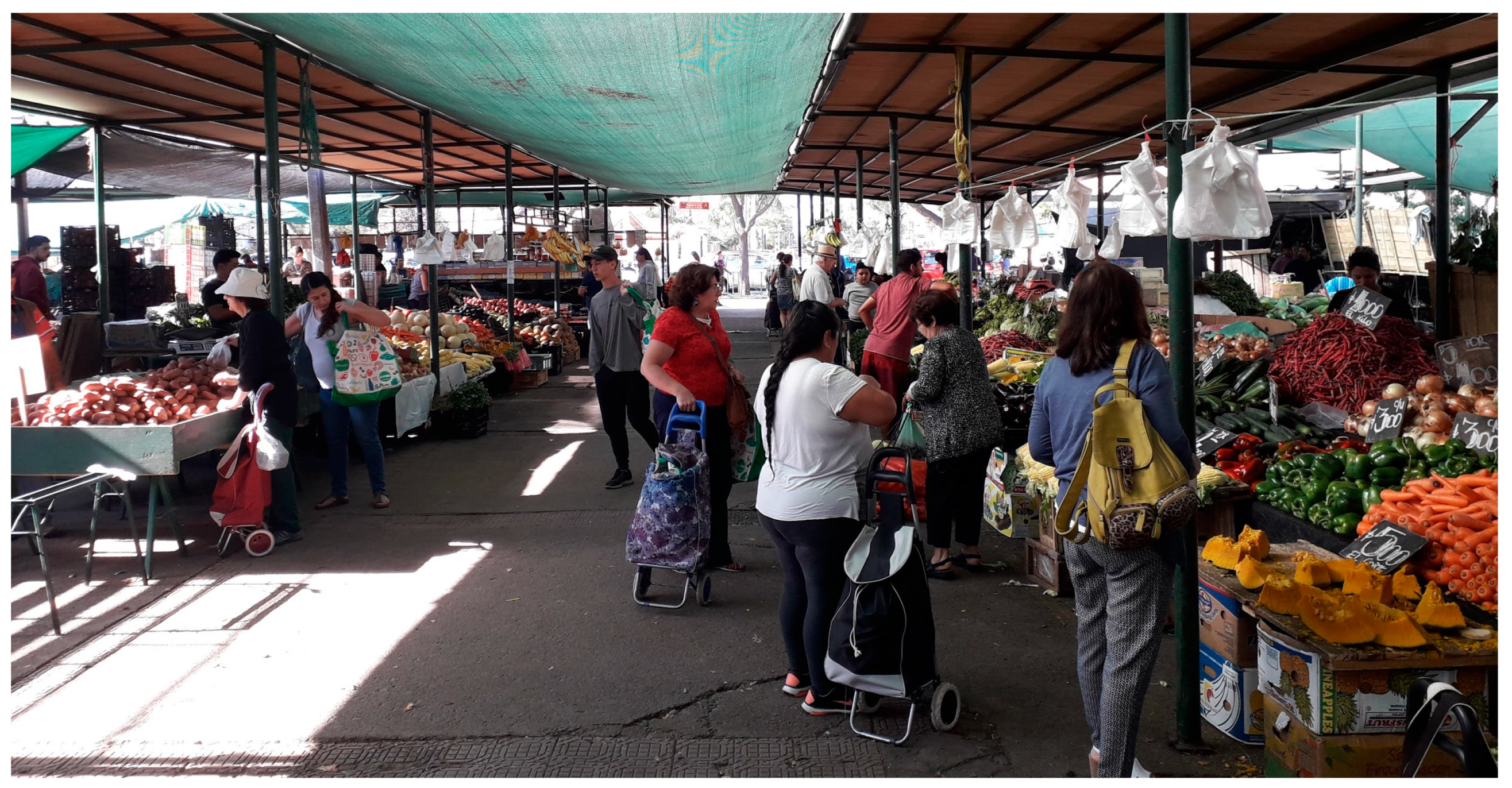
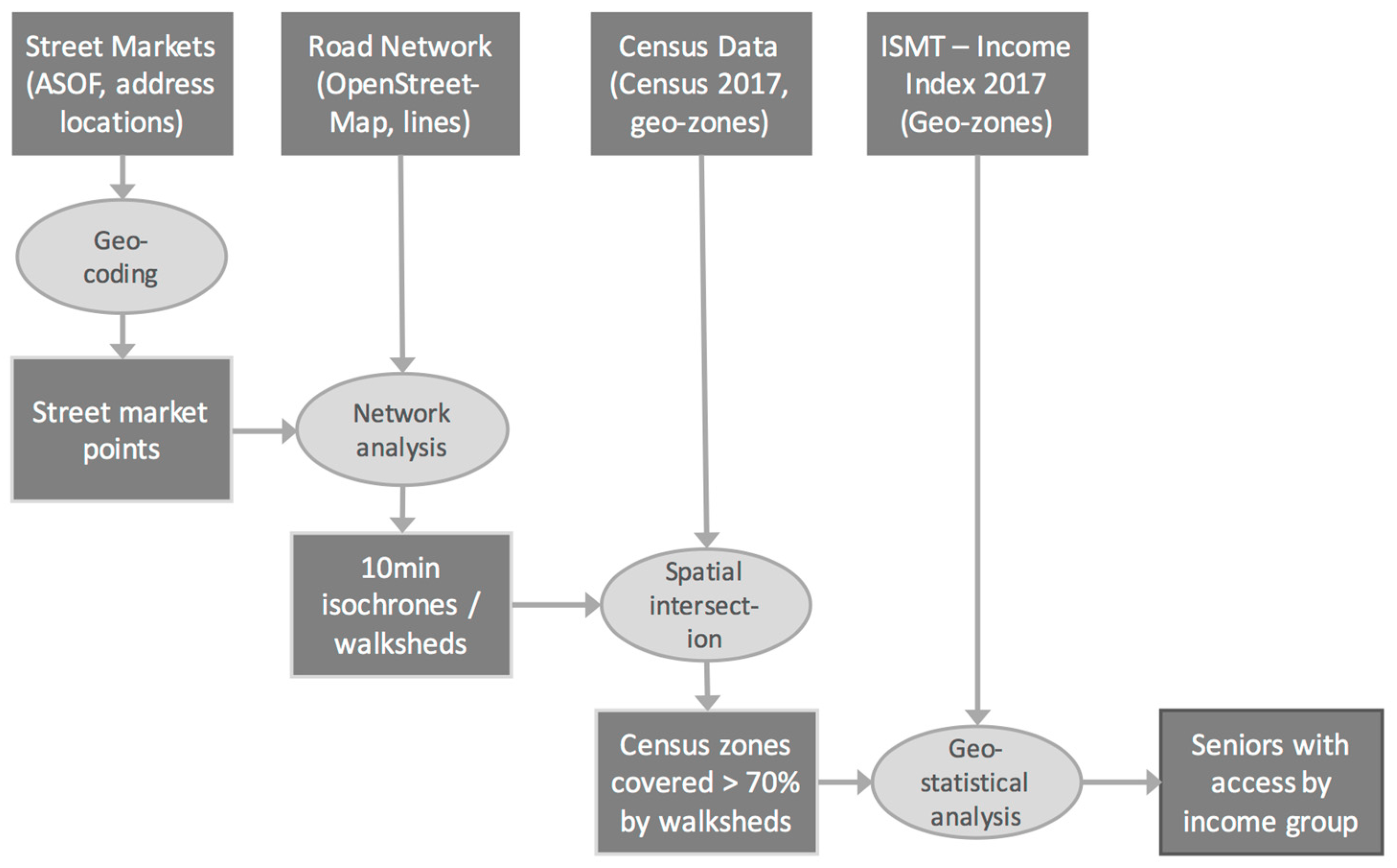
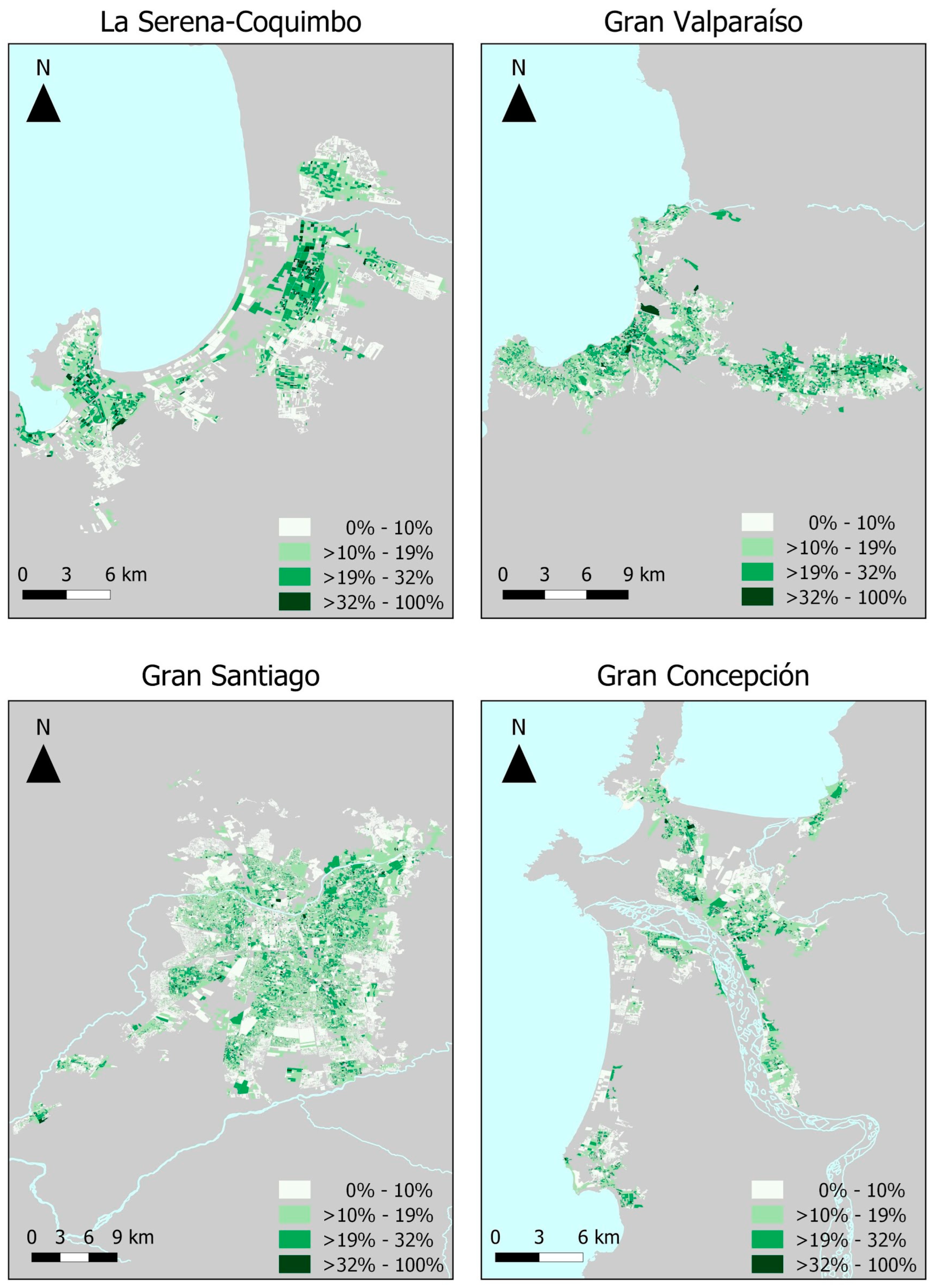
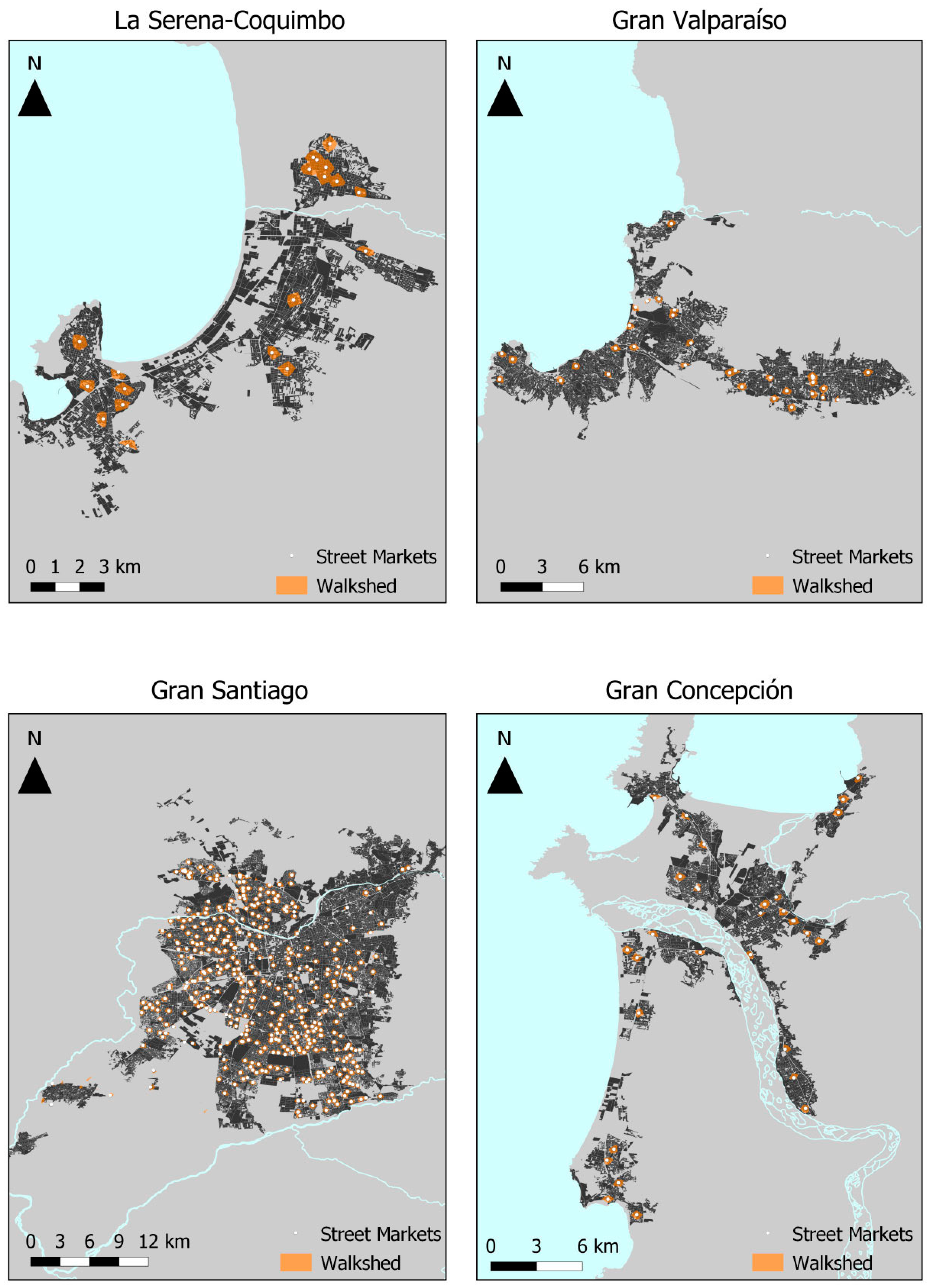
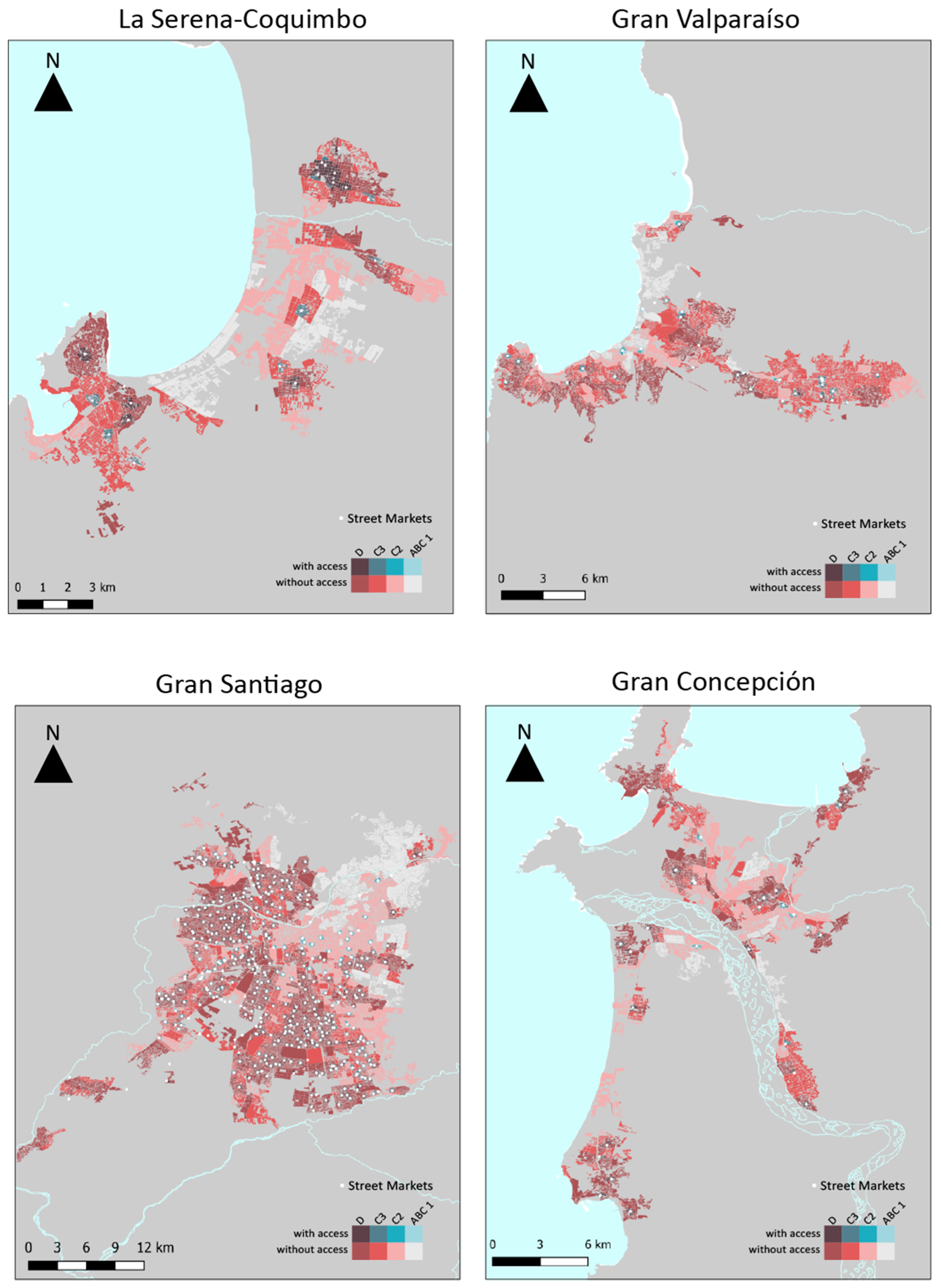
| Region | Number of Street Markets | Older People with Access | Older People without Access | % of Older People with Access |
|---|---|---|---|---|
| Arica y Parinacota | 0 | 0 | 21,111 | 0% |
| Tarapacá | 8 | 2500 | 18,817 | 11.7% |
| Antofagasta | 24 | 4664 | 34,354 | 12.0% |
| Atacama | 14 | 2646 | 18,370 | 12.6% |
| Coquimbo | 34 | 6387 | 53,036 | 10.7% |
| Valparaíso | 90 | 15,202 | 188,757 | 7.5% |
| Metropolitana de Santiago | 501 | 145,760 | 559,048 | 20.7% |
| O’Higgins | 103 | 9732 | 59,594 | 14.0% |
| Maule | 28 | 2038 | 74,436 | 2.7% |
| Ñuble | 18 | 1566 | 35,430 | 4.2% |
| Biobío | 52 | 9895 | 132,538 | 6.9% |
| Araucanía | 23 | 2105 | 64,787 | 3.1% |
| Los Ríos | 18 | 2307 | 26,631 | 8.0% |
| Los Lagos | 11 | 534 | 51,853 | 1.0% |
| Aysén | 2 | 105 | 5203 | 2.0% |
| Magallanes | 0 | 0 | 15,702 | 0% |
| Metropolitan Area | Older People in the Metropolitan Area | % Older People in Each Socio-Economic Group * | % Older People with Access to Street Markets, per Socio-Economic Group | ||||||
|---|---|---|---|---|---|---|---|---|---|
| ABC1 | C2 | C3 | D | ABC1 | C2 | C3 | D | ||
| Santiago | 664,354 | 6.6% | 20.5% | 19.5% | 53.5% | 0% | 1.4% | 3.6% | 16.9% |
| Concepción | 87,320 | 6.9% | 21.7% | 27.4% | 44.0% | 0% | 1.0% | 1.3% | 5.7% |
| Valparaíso | 118,259 | 9.7% | 14.8% | 47.5% | 28.0% | 0.3% | 1.2% | 3.6% | 1.4% |
| Coquimbo-La Serena | 38,542 | 7.7% | 19.1% | 38.5% | 34.8% | 0% | 0% | 4.6% | 5.7% |
Disclaimer/Publisher’s Note: The statements, opinions and data contained in all publications are solely those of the individual author(s) and contributor(s) and not of MDPI and/or the editor(s). MDPI and/or the editor(s) disclaim responsibility for any injury to people or property resulting from any ideas, methods, instructions or products referred to in the content. |
© 2023 by the authors. Licensee MDPI, Basel, Switzerland. This article is an open access article distributed under the terms and conditions of the Creative Commons Attribution (CC BY) license (https://creativecommons.org/licenses/by/4.0/).
Share and Cite
Vecchio, G.; Castillo, B.; Villegas, R.; Rojas Quezada, C.; Steiniger, S.; Carrasco, J.A. Elderly Walking Access to Street Markets in Chile: An Asset for Food Security in an Unequal Country. Sustainability 2023, 15, 3893. https://doi.org/10.3390/su15053893
Vecchio G, Castillo B, Villegas R, Rojas Quezada C, Steiniger S, Carrasco JA. Elderly Walking Access to Street Markets in Chile: An Asset for Food Security in an Unequal Country. Sustainability. 2023; 15(5):3893. https://doi.org/10.3390/su15053893
Chicago/Turabian StyleVecchio, Giovanni, Bryan Castillo, Rodrigo Villegas, Carolina Rojas Quezada, Stefan Steiniger, and Juan Antonio Carrasco. 2023. "Elderly Walking Access to Street Markets in Chile: An Asset for Food Security in an Unequal Country" Sustainability 15, no. 5: 3893. https://doi.org/10.3390/su15053893
APA StyleVecchio, G., Castillo, B., Villegas, R., Rojas Quezada, C., Steiniger, S., & Carrasco, J. A. (2023). Elderly Walking Access to Street Markets in Chile: An Asset for Food Security in an Unequal Country. Sustainability, 15(5), 3893. https://doi.org/10.3390/su15053893







